Nonsurgical orthopedic treatments allow Baptist Health osteopathic doctors to explore patient needs
LOUISVILLE/NEW ALBANY Sometimes, the best way to address an orthopedic treatment isn’t to immediately turn to surgery, say Baptist Health Sports Medicine physicians.
From treating the whole patient to using new techniques and treatments, there are nonsurgical ways to address orthopedic issues.
Kathleen Naylor, DO, sports medicine specialist with Baptist Health Sports Medicine, says she looks to nonsurgical options first. How to best treat orthopedic injuries often comes from listening to her patients first, and then treating the whole patient.
This allows her to look beyond the injury, she says, to come up with treatments where surgery isn’t the first option.
“If you’re looking at an athlete and you’re looking at their recovery from an injury… when you build in that primary care component, you’re able to address all of the health issues or concerns that might be affecting how an athlete is able to perform in their sport,” says Naylor. “So you’re not just looking at an orthopedic injury; you can look at their diet, their nutrition, their mental health, their sleep, all of the things that might come into play. Even address things like if they have a cold, if they’re having issues with their blood pressure, what medications are safe for them to take. So, it really does help provide full-picture and wholebody care for an athlete all from one location.”
Naylor grew up in Florida as an athlete and academic achiever. A basketball and softball player through high school, Naylor shifted her focus to academics during her undergraduate time studying exercise physiology at the University of Miami. After studying osteopathic medicine at Kirksville College in Kirksville, Missouri, Naylor did a family medicine residency and sports medicine fellowship at University Hospitals in Cleveland, Ohio.
Athlete First, Then Healer
Sports medicine was always in her mind, she says.
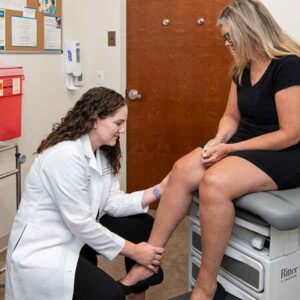
“My whole life I was excited to put Band-Aids on, and take splinters out and those type of things. As I got older, I became more amazed by the human body and what it’s capable of and how everything is so interrelated, how the body is able to adapt and heal,” she says. “From there I knew that with primary care, I would be able to build relationships and have continuity of care and be able to take care of my patients and athletes on a whole level as opposed to more specialized care.”
Naylor’s shift to primary care and nonsurgical options for orthopedic issues came out of her desire to treat the whole patient. Her training as a DO helps her see how the body as a unit functions, and that structure dictates function, especially from the musculoskeletal standpoint. Naylor says she came to realize that continuity of care with her patients and being able to manage even primary care issues helped her find nonsurgical ways to address orthopedic issues.
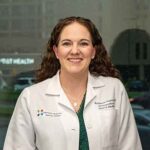
“I really enjoyed learning OMT, or osteopathic manipulative therapy, and it’s something that I still utilize in my practice and with my student athletes in the training room,” she says. “I think it’s become a really useful tool to be able to offer this type of treatment to patients, both in the office or on the sidelines.”
Those nonsurgical treatments are relevant to more than just athletes, says Naylor.
“I think when people have a musculoskeletal issue, they just assume that orthopedics is where they need to go,” she says. “But for a lot of people, if it’s just a sprain or a strain, that’s something that sports medicine specializes in. If it is something that we feel needs surgical management, then we can refer you to one of our orthopedic surgical colleagues. Oftentimes, we’re really the best place to start if it isn’t going to be something major.”
That may be a male patient who just wants to be able to walk his daughter down the aisle, or an older female patient who wants to play with her grandchildren. Naylor says that she is able to look at the how the patient’s body moves, what symptoms they are feeling and some of the side effects that they are experiencing from either an injury or medications. She then designs a treatment plan that will help them arrive at the best outcome.
Meet William A “Chance” Davis, DO
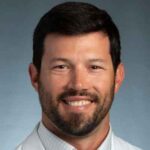
For William “Chance” Davis, DO, a physician with Baptist Health Floyd Sports Medicine in New Albany, Indiana, one of the most promising new nonsurgical treatment plans is platelet rich plasma, or PRP. Essentially, he says, it’s a treatment where doctors take a patient’s blood, spin it down in a centrifuge and remove the blood cells, leaving only platelets. As the platelets house the entirety of the response from your immune system, they help the body to heal itself.
“Previously, if someone had a rotator cuff tear in their shoulder and one of the tendons had a 50 percent tear, that’s not quite enough to need surgical intervention,” he says. “Before, all we had was anti-inflammatory medicines to prevent it from hurting. We’d get the patient into therapy to try and get them stronger in the 50 percent that they had left.”
Davis, who grew up outside of Biloxi, Mississippi, received his undergraduate degree from the University of Mississippi before going into osteopathic medicine at Pikeville College, in Kentucky. He did his residency in family medicine back in Mississippi, but moved to Indianapolis to practice family medicine for two years, where his wife Ashley McNight, DO, did her anesthesia residency. When her residency was over, the two moved to Louisville, where Davis did a sports medicine fellowship at the University of Louisville before landing at Baptist Health.
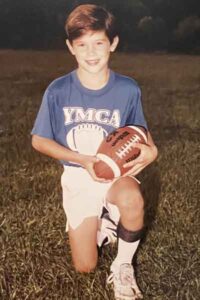
Using ultrasound technology, he says, he can find where a muscle is torn and see on the screen where to inject the PRP. “It is leaps and bounds ahead of its time,” says Davis. “Doctors are doing fantastic things with PRP and getting athletes back onto the field with ligament and muscle tears.”
Although the technology has been around for more than a dozen years, it is a therapy that is just now gaining ground, says Davis. As more insurance companies are asking for information about the procedure and agreeing to cover it, the sports medicine group is better able to provide the therapy to its patients.
“The more we’re able to research, the more we’re able to get those studies out there, the more it will be accepted,” he says. “There are very few preliminary studies, with not quite enough patients to really prove PRP works and drive the point home. But those studies are coming.”
Meet Michael Hughes, DO
PRP therapy was first used in the NFL says Michael Hughes, DO.

“I think it started in 2008 with Hines Ward, former running back for the Pittsburgh Steelers. That kind of put it on the horizon for everyone like it was a miracle cure. Now, I’m here in Louisville, Kentucky, offering it every day to patients,” says Hughes.
A Louisville native, Hughes graduated from DuPont Manual High School and Transylvania University in Lexington before going to the West Virginia University School of Osteopathic Medicine. After his residency in family medicine in Rome, Georgia, he was able to come back home to Louisville and complete a primary care/sports medicine fellowship before taking a position at Baptist Health Sports Medicine.
The PRP option is great for patients who don’t want to have surgery, he says.
“I think, a great option. I have a conversation with patients. I even get consults where some orthopedist is saying, ‘Go see these guys for PRP.’”
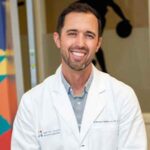
PRP is a good treatment for rotator cuff repairs, chronic tennis elbow, patellar tendonitis, Achilles tendonitis, plantar fasciitis, and others, says Hughes.
His patients range from 10 to 99, and PRP helps with everything from a young person training for an Ironman to an older patient with chronic injuries where his choice is to counsel patients to hold off on surgery as long as they can.
The only contraindication for PRP, he says, is a patient with a low platelet count.
“If you don’t have enough platelets to go around the body, then we’re not going to be able to do that therapy,” says Hughes. “I will talk about it with anybody, as long as the diagnosis makes sense to discuss.”
As a DO, however, he puts a lot of value on other nonsurgical treatments like losing weight and getting up to move, as well as using office-based ultrasound. “I utilize it primarily for guided injections for multiple reasons. At times, it’s from a referral from other specialists, such as orthopedic surgeons to help with surgical planning or to delay surgery if patients find significant pain relief from the injection they receive. There are several good studies in literature validating ultrasound use for visco-supplementation, commonly called gel shots.
“I think that’s where a lot of my intersection comes in— where patients are wanting to become more active but they can’t get there because they have a knee that’s bothering them and it’s holding them back,” he says. “Probably the biggest problem we have right now is our society’s inactivity and sedentary lifestyles.”
View from the Top
“Overall, the vast majority of bone and joint complaints are not surgical in nature,” says Mark A. Puckett, MD, CAQSM, medical director, Baptist Health Sports Medicine.

He continues, “Our focus in nonsurgical primary care sports medicine is to treat those nonsurgical problems with excellence from start to finish—whether that is discussing injury prevention methods, intervening early for acute injuries, or stopping a pattern of long- term overuse. That also demands integrating well with our surgical colleagues when we encounter those conditions where surgery is the best solution, and we are very fortunate to have a healthy team with mutual appreciation for our differing skills and focus.
“My goal as a program is that we are able to deliver the very best care to patients of all activity levels to help maintain long-term healthy lifestyles,” says Puckett.
Puckett received his medical degree from the UofL School of Medicine. He did both his family medicine residency and sports medicine fellowship at Self Regional Healthcare in Greenwood, South Carolina.



